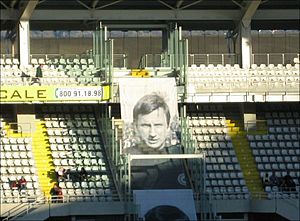Giorgio Ferrini facts for kids

Ferrini as assistant manager at Torino in 1976
|
||||||||||||||||
| Personal information | ||||||||||||||||
|---|---|---|---|---|---|---|---|---|---|---|---|---|---|---|---|---|
| Full name | Giorgio Ferrini | |||||||||||||||
| Date of birth | 18 August 1939 | |||||||||||||||
| Place of birth | Trieste, Italy | |||||||||||||||
| Date of death | 8 November 1976 (aged 37) | |||||||||||||||
| Place of death | Turin, Italy | |||||||||||||||
| Height | 1.76 m (5 ft 9 in) | |||||||||||||||
| Position(s) | Midfielder | |||||||||||||||
| Youth career | ||||||||||||||||
| 19??–1955 | Ponziana | |||||||||||||||
| 1955–1958 | Torino | |||||||||||||||
| Senior career* | ||||||||||||||||
| Years | Team | Apps | (Gls) | |||||||||||||
| 1958–1959 | → Varese (loan) | 34 | (10) | |||||||||||||
| 1959–1975 | Torino | 443 | (42) | |||||||||||||
| Total | 477 | (52) | ||||||||||||||
| International career | ||||||||||||||||
| 1960 | Italy Olympic | 3 | (0) | |||||||||||||
| 1962–1968 | Italy | 7 | (0) | |||||||||||||
| Managerial career | ||||||||||||||||
| 1976 | Torino (Assistant) | |||||||||||||||
|
Medal record
|
||||||||||||||||
| *Club domestic league appearances and goals | ||||||||||||||||
Giorgio Ferrini (born August 18, 1939 – died November 8, 1976) was a famous Italian football player. He played as a midfielder and later became a football manager.
People called him La Diga, which means 'The Dam'. This nickname showed how good he was as a defensive midfielder. He played for Torino from 1959 to 1975. He is the player with the most appearances for Torino, playing 566 games. He won the Coppa Italia twice with Torino, in 1967–68 and 1970–71. Giorgio Ferrini also played for the Italian national team. He helped Italy win the European Championship in 1968.
Contents
Playing for Clubs
Ferrini started playing football in the youth team of Ponziana. In 1955, he joined the youth system of Torino. He stayed there for three years, learning and improving his skills.
In 1958, Ferrini was loaned to Varese, a team in Serie C. He played one season there and scored 10 goals. He helped the team stay in the league.
After his loan, Ferrini returned to Torino. He made his first team debut on September 20, 1959. This was an away game against Sambenedettese. A week later, he scored his first goal for Torino against Cagliari. He played 38 games that season and scored three goals. Torino was promoted to Serie A, the top Italian league. Ferrini became a very important player for the club.
He played for Torino for 16 seasons. He became the club's record holder for most games in the top league. He scored 39 goals in 405 Serie A matches. In total, he played 566 games and scored 56 goals for Torino. This includes games in the league, Coppa Italia, and European competitions. He helped Torino win the Coppa Italia in 1967–68 and 1970–71. His last game was on June 22, 1975, in a Coppa Italia match against Napoli.
Playing for Italy
Ferrini was chosen to play for the Italian Olympic team in 1960. He played three games in the Olympic tournament held in Rome. Italy finished in fourth place.
He was first called up to the Italian national team in 1962. This was just before the 1962 FIFA World Cup in Chile. During the World Cup, he was involved in a famous match against Chile. This game is known as the Battle of Santiago.

Early in the match, Ferrini was sent off by the referee. He was asked to leave the field, but he did not want to go. Police officers had to come onto the field to remove him. Italy lost the game 2–0 and was eliminated from the tournament.
Despite this incident, Ferrini continued to play for the national team. His last game for Italy was on June 8, 1968. This was the first game of the final of the 1968 UEFA European Championship against Yugoslavia. He played a total of seven matches for the Italian national team.
How He Played
Giorgio Ferrini was a very hard-working and energetic midfielder. He was known for his great stamina and strong tackles. He was also very dedicated and consistent in his play. Even though he wasn't the most skillful player, he was a great leader on the field.
He could play in many different midfield positions. He could be a defensive midfielder or an attacking central midfielder. He was a tough player, but he was also known for being fair.
Later Life and Death
After he stopped playing football, Ferrini became an assistant coach for Torino. This was in the season when Torino won the Serie A title. Sadly, he suffered two serious health problems in 1976. He passed away on November 8, 1976, at the age of 37.
He is buried in a small cemetery near Superga. This is the same area where the famous Grande Torino team died in a plane crash.
Achievements
Club Honors
- Torino
- Coppa Italia (2): 1967–68, 1970–71
International Honors
- Italy
Individual Awards
- Torino F.C. Hall of Fame: 2014
See also
 In Spanish: Giorgio Ferrini para niños
In Spanish: Giorgio Ferrini para niños



